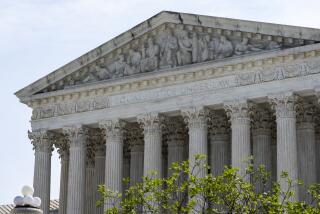Justices to Rule on Displays of Ten Commandments
- Share via
WASHINGTON — With the nation divided over the role of religion in government, the Supreme Court announced today it will decide whether cities and states can display the Ten Commandments inside or outside their public buildings.
Plaques and monuments depicting the biblical commandments stand at the center of the continuing dispute over the meaning of the U.S. Constitution. Does it create a “wall of separation between church and state,” as President Thomas Jefferson once said, or does it permit officials to publicly recognize this nation’s religious heritage?
The justices agreed to hear two cases to decide whether a government’s display of the Ten Commandments violates the 1st Amendment and its ban on “an establishment of religion.” The first concerns a six-foot granite monument just outside the Texas Capitol in Austin. A gift from the Fraternal Order of Eagles in 1961, it stands in the vicinity of several other monuments, including memorials to Texas war veterans. The commandments proclaim, “I AM the LORD thy God. Thou shalt have no other gods before me.”
The case has an unusual history. Thomas Van Orden, a former criminal defense lawyer who became homeless after suffering psychological ailments, sued the state and argued his own case.
“I didn’t sue religion,” Van Orden, 59, said. “I sued the state for putting a religious monument on Capitol grounds.” Though he lost in the federal courts, the Supreme Court agreed to hear his appeal.
The second case arose when judges in three eastern Kentucky counties decided in 1999 to post copies of the Ten Commandments in their courthouses. The American Civil Liberties Union sued them and won, but the high court agreed to hear the appeal from the judges.
Neither case directly involves a classroom. In 1980, the high court struck down a Kentucky law that called for posting the Ten Commandments in classrooms.
The cases also do not involve Roy Moore, the Alabama justice who was ousted after he defied a federal court order to remove a Ten Commandments monument from the state supreme court building. On several occasions, including last week, the Supreme Court has turned away appeals from Moore.
The high court has been closely split on the issue of religion, and the outcome in the new cases probably depends on Justice Sandra Day O’Connor. In the past, she has asked whether the government’s action appears to endorse religion. If so, she has voted to strike it down.
For example, she joined her liberal colleagues in ruling that city officials in Pittsburgh went too far when they displayed a scene of Christ’s birth in the county courthouse during the holidays. O’Connor also joined with the liberals to rule that school officials may not choose students to deliver prayers over the public address system.
However, she has also voted with her conservative colleagues in upholding the use of state tax money to send children to religious schools. These “vouchers” do not endorse religion, she said, but merely give parents more choices.
The eight other justices are more predictable. The conservative faction, led by Chief Justice William H. Rehnquist, says the government may aid religion in general, so long as it does not favor a particular faith. The liberals, led by Justice John Paul Stevens, support the separation-of-church-and-state principle and say the government has no business promoting religion.
The two cases will be argued in February and decided by June. They are Van Orden vs. Perry and McCreary County vs. ACLU.
Meanwhile, the court will also decide whether prisoners and others in state custody are entitled to full religious freedom. The 1st Amendment protects the “free exercise of religion,” but state officials say they need not make special arrangements for meals and services for inmates who practice non-traditional religions.
Congress sought to protect religious freedom four years ago when it passed a measure saying officials may not “impose a substantial burden” on the religious rights of inmates. But a U.S. appeals court struck down the law on the grounds that it amounted to favoritism for religion.
The high court said it will take up a case brought by Ohio inmates who are Satanists and Wiccans to decide the constitutionality of the federal law.
More to Read
Sign up for Essential California
The most important California stories and recommendations in your inbox every morning.
You may occasionally receive promotional content from the Los Angeles Times.










